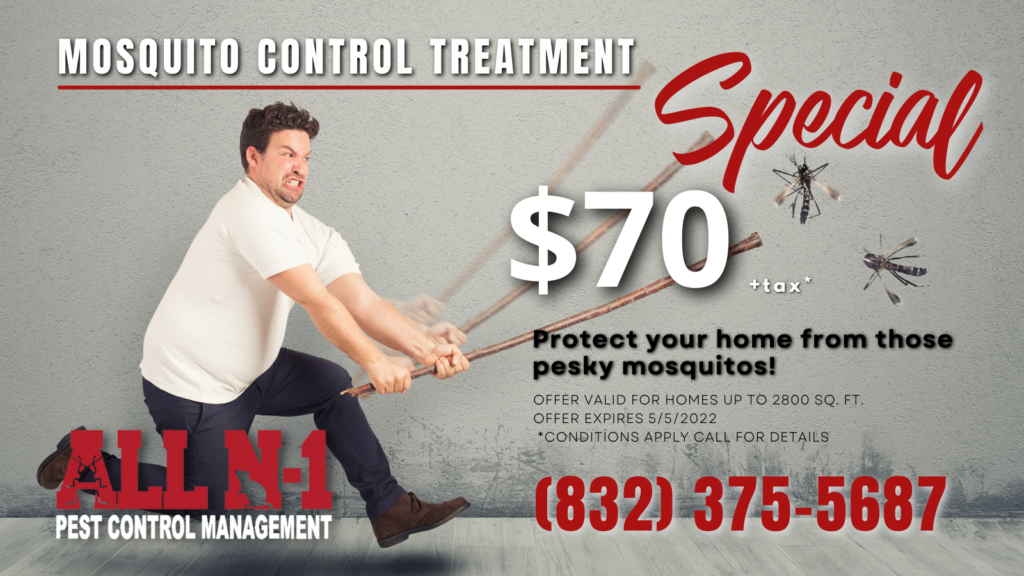
Pest Blog Post

$70 plus tax
Mosquito Control Treatment Special
Valid from April 5 thru May 5, 2022.
We can help protect your yard from pesky mosquitos so you can enjoy your outside spaces and not get eaten alive by mosquitos this summer.
* Offer valid for homes up to 2800 sq. ft..
*Cannot be combined with any other specials or offers.
Amazing Tips For Homeowners, Everything You Need Know To Keep Termites Away!
At first site a single termite doesn’t look dangerous or menacing, but a colony of termites can cause serious damage to a home in a very short amount of time. As the weather in Houston is getting warmer, termites are becoming more active and tend to swarm after rainfall on a warm day. They began to start swarming anywhere from February until late in the fall depending on the type of termite.
What termites are common for the Houston Area?
Subterranean Termites
These termites construct one-of-a-kind tunnels, frequently referred to as “mud tubes,” to attain meals sources and shield themselves from open air. They devour wood 24 hours a day, seven days a week, the use of their saw-toothed jaws to chunk off small fragments of wooden one piece at a time. Over time, subterranean termites can seriously harm a constructing structure, now and again inflicting a complete collapse.

Physical Characteristics of a Subterranean Termites:
- Color: Creamy white to dark brown/black
- Legs: 6
- Shape: Long, narrow and oval
- Size: 1/8 inch long
- Antennae: Yes
- Region: Found throughout the U.S.
Signs of infestation of subterranean termites:
- presence of mud tubes on the exterior of the home
- soft wood in the home that sounds hollow when tapped, darkening or blistering of wood structures, uneven or bubbling paint, and small piles of feces that resemble sawdust near a termite nest
Drywood Termites
Drywood Termites are a termite species recognized for thriving in hard, dry wood in a home. This can consist of structural timbers as properly as furniture, photo frames and banisters.

Physical Characteristics of a Drywood Termites:
- Color: Creamy white to light brown
- Legs: 6
- Shape: Long, narrow and oval
- Size: 3/8 to 1 inch long
- Antennae: Yes
- Region: Primarily found coastally from South Carolina westward to Texas and up the west coast of California
Signs of infestation of drywood termites:
- Swarms of termites or discarded wings are a frequent signal of an infestation, particularly close to mild sources.
- Drywood termite droppings are some other tell tale sign. Drywood termite droppings seem to belike small mounds of tiny pellets that are additionally known as frass.
What season are termites more active in?
They began to start swarming anywhere from February until late in the fall depending on the type of termite.
How do I know if I have termites?
- Stuck Windows or Doors. Do you have a window or door that recently feels stuck, or suddenly became much harder to open or close?
- Damage under Paint or Wallpaper
- Termite Swarmers (the winged adults) & Discarded Wings
- Mud Tubes
- Termite Droppings
Do termites bite people?
Termites do bite wood and do attack other insects, but they do not bite people.
What can homeowners do to avoid termites?
- Eliminate wood in contact with the ground.
- Do not let moisture accumulate near the foundation.
- Reduce moisture and humidity in crawl spaces
- Never store firewood or wood debris against foundations or inside crawlspaces.
- Use mulch sparingly, especially if you already have termites or other conducive conditions.
- Consider having the home treated by a All N-1 Pest Control Management
Do you offer a free termite inspection?
Yes, All N-1 Pest Control is currently offering Free Termite Inspections. Check out our Pest Control Specials page for more information on saving money on your pest control.
